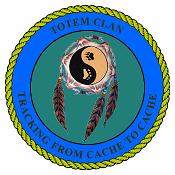
Most of the rock that forms the Wichita Mountains is granite; however during their formation many other types of rocks were formed. Most of these have weathered away. One the rocks formed was gabbro.
Gabbro refers to a group of dark, coarse-grained, intrusive igneous rocks that are similar in makeup to basalt. Gabbro forms when molten magma is trapped beneath the Earth's surface and cools slowly. If this magma reached the surface it would form basaltic rock. Gabbro is generally coarse grained, with crystals in the size range of 1 mm or greater. Much of the Earth's surface is underlain by gabbro within the oceanic crust.

The Roosevelt Gabbros are one of two gabbro formations within the Wichita chain. The formation extends from here back south and east toward and under the Wichita Mountain Wildlife Refuge. The Roosevelt Gabbros underlie the Mount Scott Granite sheet, which forms the peaks seen in and around the refuge. The formation is also well exposed in the Mt. Sheridan area.
The gabbro itself dates to about 530 to 520 million years old.
Roughly 550 million years ago this area was being pulled apart. Over time this rift formed a sea. This rifting allowed magma being forced up through the foundation rock to empty into the sea. There it cooled rapidly and become basalt. The basalt has long since eroded away and no outcrops are available for viewing.

Large amounts of the magma that did not reach the surface slowly cooled forming gabbro. The black gabbro of the Roosevelt Gabbros was formed at this time.
 After this the period of basalt and gabbro formation, magma formed from the melting of foundation rock poured out over the basalt at the surface to form rhyolite, which can be found on the far eastern end of the chain.
After this the period of basalt and gabbro formation, magma formed from the melting of foundation rock poured out over the basalt at the surface to form rhyolite, which can be found on the far eastern end of the chain.
The magma that did not reach the surface and become rhyolite slowly cooled underground and formed granite found throughout the range.
 Afterwards the forces of uplift and erosion have exposed the layers that were formed during the many phases of volcanic activity leaving us with the Wichita Mountains.
Afterwards the forces of uplift and erosion have exposed the layers that were formed during the many phases of volcanic activity leaving us with the Wichita Mountains.
The dark almost black rock you see in the exposed face is gabbro. The layering of the rocks by the various phases of volcanism can be clearly seen here. Driving east on Highway 19 you can see some more example of this layering. Going south on Highway 183 toward Mountain Park you can see the how the granite rocks overlay the gabbro.
While you are here look at the gabbro. Also notice how the gabbro is capped by other types of rocks.
To receive credit for this cache, email me the answers to the following questions.
1. How thick is the exposed gabbro layer at the cut?
2. Describe the rock itself.
3. What are the rocks in the overlying layer like?
 Congratulation to 2Moore on the FTF.
Congratulation to 2Moore on the FTF.

Another Quality Clan Hide